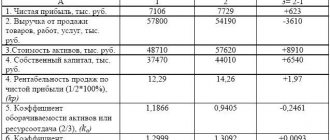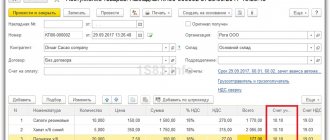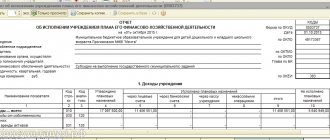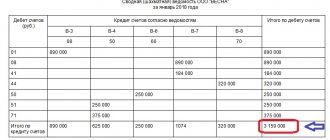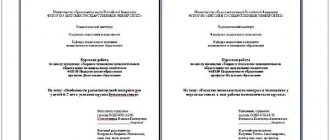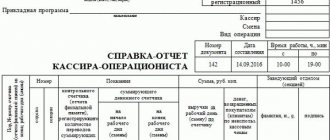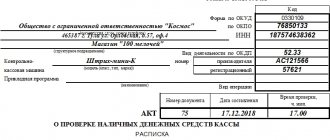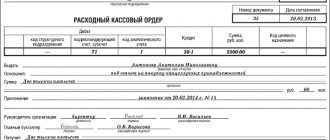Operations in the report
The shift production report (hereinafter referred to as OPS) is intended to document the following types of enterprise activities:
- Release of goods, materials, finished products, semi-finished products - that is, release of any product produced by the enterprise;
- Services provided to the company's production units;
- Writing off materials as expenses;
- Release by production of returnable waste.
All these operations can be documented in the OPS document.
Registration in 1-C Accounting
The OPS document is located in the accounting program in the Production tab. If there is already at least one completed document of this type, then when you go to the OPS section, a list with previously completed production documents will open. In the open document you need to indicate the following information:
- The organization and its division in which the manufactured products were formed;
- Issue date;
- The warehouse where the finished products were received;
- List of manufactured products indicating quantity, planned price and accounting account;
- An account in which all costs for the production of a given batch of products will be taken into account. As a rule, this is 20 or 23 counts.
https://youtu.be/pEyYq7tkiAI
Practical task
Arrange product release. Write off materials according to specification
- Date: 02/20/2015
- Cost division: Production department
- Products: Yolka
- Quantity: 120
- Planned price: 1000 rubles.
- Accounting account: 43
- Specification: Christmas tree
Arrange product release. Write off materials according to specification
- Date: 02/23/2015
- Cost division: Production department
- Products: Pine
- Quantity: 150
- Planned price: 1100 rubles.
- Accounting account: 43
- Specification: Pine
Arrange product release. Write off materials according to specification
- Date: 03/23/2015
- Cost division: Production department
- Products: Yolka
- Quantity: 70
- Planned price: 1000 rubles.
- Accounting account: 43
- Specification: Christmas tree
Arrange product release. Write off materials according to specification
- Date: 03/23/2015
- Cost division: Production department
- Products: Pine
- Quantity: 160
- Planned price: 1100 rubles.
- Accounting account: 43
- Specification: Pine
https://youtu.be/vauayNDgmtQ
Next Previous
These features are available to both users of local versions and cloud solutions, for example 1C:Fresh, 1C:Ready Workplace (WWW) . To purchase boxed versions or rent the 1C:Accounting 8 program in the cloud, please call +7(499)390-31-58, or e-mail: [email protected]
We recommend that you read the sections
Purchase of goods and materials and settlements with suppliers
| Directories. Documentation. Operations. |
| How to create a user with “Administrator” rights in 1C Accounting 8.3 |
| Closing a period in 1C Accounting |
| Interface Taxi 1C Accounting 8.3 How to switch to bookmarks, 1C Accounting 7.7 |
Result
When creating and posting an OPS document in 1-C Accounting, the following transactions are generated:
Debit 41 (43) Credit 20.1 - finished products released,
Debit 20.1 Credit 10.1 - materials for the manufacture of these products are written off.
Let's look at an example for a more precise description of the postings.
Example 1.
From the production workshop of Reshenie LLC, the foreman handed over to the accountant a report that the workshop produced 100 kg of sausage. In this case, 60 kg of beef, 20 kg of pork, 10 liters of water, 10 kg of seasoning mixture were consumed. The accountant will draw up the OPS document, as a result of which the following transactions will be generated:
Debit 41 Credit 20.1 100 kg 30,000 rubles - products released
Debit 20.1 Credit 10.1 60 kg 12,000 rubles - beef written off
Debit 20.1 Credit 10.1 20 kg 4,000 rubles - pork written off
Debit 20.1 Credit 10.1 10 kg 1,000 rubles - water written off
Debit 20.1 Credit 10.1 10 kg 5,000 rubles - seasoning mixture written off
The write-off of materials does not always involve the execution of this document. In order for materials to be written off, when drawing up a production report, you need to put a mark indicating that the materials are written off using this document. If the mark is not marked, then you need to write off the materials using another document - the Request-invoice.
Fill out the report as follows: a) balance at the beginning of the day - according to the report for the previous day b) receipt from the commodity and raw materials department and other workshops - based on receipt documents receipt of petroleum products from production and mixing - respectively, according to production reports and information on mixing in ) issue of petroleum products and consumption - according to the same documents as receipt d) balance at the end of the day - based on information or an act on the availability of petroleum products, the report on the movement of petroleum products in the commodity and raw materials department contains, in addition, information on the receipt of petroleum raw materials from suppliers and on the delivery of petroleum products to buyers.
[p.231] If there are discrepancies in the reports of technological departments, production output is adjusted. If N- -P is RZh, then production output decreases if N- -P is R [p.231] Centralization of accounting involves the concentration of synthetic and analytical accounting, drawing up balance sheets and reporting in the main accounting department. At the same time, in the divisions of the organization (shops, teams, departments, sections) primary accounting is carried out by drawing up primary documents for all business transactions. Data from primary documents is grouped in cumulative and grouping statements, as well as in production reports and reports on the movement of material assets. Next, the documents are sent to the main accounting department, where these documents are checked, processed and their data is entered into the registers of synthetic and analytical accounting. [p.201]
Currently, partial decentralization of accounting is encountered in practice. It lies in the fact that in the divisions of the organization, along with documents and summary production reports (statements), accounting entries are compiled, i.e. Analytical accounting is maintained, accounting data is summarized and grouped, but their generalization is limited to the preparation of production reports. Partial decentralization of accounting, in particular, is used in organizations where divisions operate on the principles of economic (commercial) accounting and use modern forms of organizing production, labor and payment. [p.202]
Documents for accounting for the consumption of seeds, planting materials, mineral fertilizers, materials for routine repairs of fixed assets are requirements-invoices, limit-fence cards, acts on the use of fertilizers and pesticides, acts on the write-off of seeds. For worn-out or low-value and wear-out items released into production, a write-off act for low-value and wear-out items is drawn up. The removal of manure from livestock farms to fields or vegetable gardens is documented. Auxiliary production services provided to the crop growing industry are reflected in the production reports of vehicles, repair shops, power plants, etc. [p.307]
Based on the data from primary documents compiled directly at the sites, and entries in the work and expense journal at the end of the reporting month, a production report is compiled. This report is a summary document reflecting the volume of work and output of a department, team or other area and all costs of the reporting period. [p.308]
The production report form allows you to group costs in the required sequence based on primary and cumulative documents, enter data on costs and product output into synthetic and analytical accounting registers, and analyze the costs of production and receipt of products. [p.308]
A summary document reflecting the costs and output of livestock products is a production report. [p.312]
At the end of the month, the totals are calculated in the accumulative sheets, on the basis of which a production report (garage report) is compiled. The amounts of accrued wages for drivers of trucks and cars are transferred from closed waybills to the working time sheet, making a counter check with the data of the accumulative sheets. [p.149]
If workshops (sites) prepare production reports, their data must be verified with the indicators and statement No. 11. [p.63]
Data on the actual cost of finished products received by a non-trading organization during the month (reporting period) is formed on the basis of reporting calculations, journals (tabulagrams) of finished products, production reports and other similar accounting registers. [p.260]
Indicators of specific consumption of raw materials, materials and fuel are also reflected in planned and reported calculations of the cost of products and in technical and production reports of some industries. [p.69]
Therefore, if such reports are eliminated, there will be absolutely no negative consequences, and the positive ones will consist of a large reduction in important cost items. Select one of the production reports whose usefulness you doubt, and calculate the costs that you will get rid of along with it [p.424]
A balanced report does not contain unnecessary parameters, thereby eliminating unnecessary analysis and limiting itself to only the information necessary for the addressee. The analysis comes down to several fundamentally important points. It should be remembered that production reports provide the feedback necessary to achieve set goals, evaluate progress and collect data used in strategic planning. [p.72]
The feedback provided by production reports should help make adjustments necessary to achieve set goals. [p.72]
In addition to production reports about the organization, attention should be paid to the regular informal dissemination of operational information about the state of affairs. [p.73]
Evaluation of pricing results based on production reports of company divisions. [p.106]
Inspection of workshops. The organization of production—the work of production units—should be analyzed down to the smallest detail. The technological flow for each type of production reflects the actual state of the production organization. The inspection of each production workshop begins with the formulation of the functions performed and the main operations. The fulfillment of tasks of each structural unit of a production nature is analyzed, up to the moment of transfer of finished products for shipment. A list of equipment is compiled, broken down by main groups, a list of main production workers and support personnel, the number of working hours for a certain period (usually a week) is specified, methods of calculating wages are considered, the procedure for compiling reports on working hours, officials are indicated for whose According to the order, the corresponding work begins. Methods of production planning and control are listed in detail, including the order and time for compiling production reports, as well as the persons for whom these reports are compiled. The intra-shop functions of equipment care and maintenance of production facilities are determined, indicating the tasks, their implementation and the preparation of appropriate reports on them. Control methods are indicated, a description of the internal layout of the workshops is given, and the assistance provided by the administration to each structural unit is described. [p.305]
Once the appropriate basis for allocating overhead costs has been determined, overhead cost rates are applied directly to individual operations when accounting for production costs. If the production cost department determines overhead costs based on the number of hours worked by the machine, the cost document for the operation must include a line indicating the number of hours worked by the machine for each operation. Then the number of hours worked is taken from workers’ time cards or from daily production reports and entered [p.559]
The specific reasons for overspending are clarified based on data from work orders, additional payment slips, simple slips and shop production reports. [p.430]
The subsystem for managing the use of material resources includes the tasks of rationing the consumption of materials (analysis of the actual consumption of materials by type of product and technological processes, development and approval of consumption standards, provision of production with material resources, the procedure for calculating the standard of working capital, rationing of transport and warehouse costs, organization of cooperative supplies, carrying out inventory of material assets, drawing up production reports and writing off material assets from accountable persons), expanding the use of advanced types of materials (identifying [p.97]
On subaccount 23-7, Other types of auxiliary production separately take into account, in particular, the costs of electricity supply, heat supply, water supply, gas supply and refrigeration units. The costs of the services of these auxiliary productions are determined by including the cost, respectively, of electrical, thermal energy, water, gas supplied from outside, as well as the cost of electrical and thermal energy received from power plants related to auxiliary industrial enterprises on the balance sheet of the agricultural enterprise. The distribution of costs for these services among consumers is carried out monthly in proportion to the amount of energy, water, gas consumed and the average planned cost per unit, with adjustment at the end of the year based on actual costs (except for services provided by auxiliary production). Production reports for each type of auxiliary production are compiled monthly using accumulative sheets or cost journals. [p.198]
Based on data from cumulative registers (magazines, statements), production reports are compiled for each production division, which are used in consolidated cost accounting. [p.206]
Consolidated synthetic accounting of production costs is maintained in order journals No. 10/2 and 10/3 by accounts. Analytical cost accounting is carried out for each object in production reports. [p.206]
Information about the actual work performed and costs are available in the accounting registers and the production report for crop production, which provides data on the volume of work performed, labor costs, consumption of seeds, fertilizers and other materials and product yield for each crop. Comparison of actual results with planned targets allows you to assess the level of plan implementation for a month, quarter, since the beginning of the year or for a separate period of work. [p.218]
The primary documents for accounting for material costs of production are limit or limit-fence cards and requirements, as well as production reports. At some enterprises, materials issued using limit cards are written off directly to production costs. The remainder of unused materials is recorded as a return from production. This procedure somewhat reduces the number of accounts, but sets the accounting department the task of strengthening operational control over the rational use of these values. [p.334]
At the end of the month, each workshop submits a production report to the accounting department, which consists of three sections [p.128]
At the bakery, when checking the shift production reports of foreman M.A. Kravchenko for December 199, the following was established [p.104]
Date Numbers of shift production reports Flour consumed Bread baked, kg [p.104]
Draw up a production report for the workshop foreman, explain the methodology for checking it, and what useful information the auditor can get when checking it. [p.124]
The actual movement of finished products is analyzed based on production reports and reports on the movement of material assets in warehouses. The auditor can use techniques such as scanning, tracking, arithmetic control, etc. to check this area of accounting. At the same time, the organization of warehouse accounting of finished products, the correctness and timeliness of execution of primary documents and the reflection of their data on accounting accounts are clarified (Appendix 20). [p.148]
Statement No. 11 is filled out in the accounting department of the enterprise on the basis of production reports of workshops, invoices for the return of materials, accumulative and grouping statements on the movement of low-value and wearable items and other documents that allow determining the volume of received and returned valuables of various types by each workshop, as well as those remaining in the workshops and spent. The indicators of statement No. 11 are reflected in section III of statement No. 10 (consumption of workshop independent storerooms and balances in workshops that do not have independent warehouses). [p.167]
Production report on the movement of semi-finished products among spinning departments [p.191]
With a non-semi-finished accounting option, as is known, the transfer of semi-finished products from one transition (department) to another is not reflected in the accounting system, however, control over their safety must be organized at each enterprise. The practice of the Krasnokholmsky plant shows that such control can be carried out for each processing stage, not only in quantity, but also in cost. An example of this is the production report compiled in the spinning production of this mill (Table 9.1). The report reflects the movement of semi-finished products and their balances in each department in physical and value terms. Semi-finished products at all technological stages are assessed at an average price. [p.192]
Production reports are prepared quarterly and cover all areas of the company's activities. Writing frequency [p.72]
The method of distribution based on standard flow rate used in the standard method deserves attention. The basis for the calculation is the production reports of workshops on the output of finished products (Table 8.2). They show standard consumption by types of main products actually produced and actual consumption for the workshop as a whole. Deviations are distributed across all types of main products in proportion to standard consumption in physical terms. This option has the advantage that it is based on product standards, and not on a conventionally calculated value. At the same time, the size and causes of deviations are not linked to the production of individual types of products. [p.126]
The completeness of the receipt of manufactured products can be checked by drawing up an alternative balance of consumption of raw materials and materials, output of finished products based on standard costs. To check the volume of production, data from primary documents and production reports, inventory reports of unfinished products are used [p.147]
Specification
In order to be able to document the release of a product in one document and write off the materials that were spent on its production, it is necessary that a specification be drawn up for each type of product. A specification is a list of materials that are needed to produce one unit of product. To create a specification, you need to go to Directories, and then select the “Item Specifications” section. In this section, you need to document how much of what you need to spend from materials to create a unit of production, and so on for each type of product manufactured by the enterprise.
Important! If there is no specification for the manufactured product, the program will not be able to write off the materials spent on its production. In such a situation, you will have to formalize this operation with the “Demand-invoice” document.

